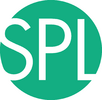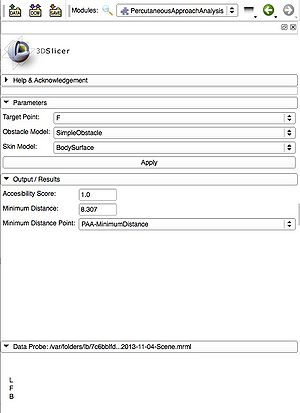Documentation/Nightly/Extensions/PercutaneousApproachAnalysis
|
For the latest Slicer documentation, visit the read-the-docs. |
Introduction and Acknowledgements
|
This work is supported by Shiga University of Medical Science (SUMS) in Japan, NA-MIC, NCIGT, and Slicer Community.
This work is also supported in part by the National Institute of Health (R01CA111288, P01CA067165, P41RR019703, P41EB015898, R01CA124377, R01CA138586, R42CA137886), and was presented in CARS 2014 meetingMedia:CARS2014 Murakami.pdf. | |||||||||
|
Module Description
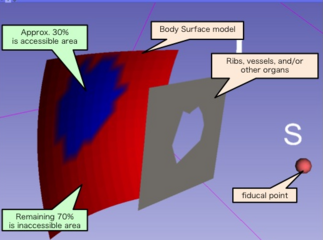
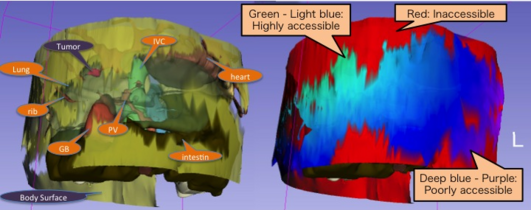
The Percutaneous Approach Analysis is used to calculate and visualize the accessibility of liver tumor with a percutaneous approach. The software uses the “ray-tracing” method in which the target tumor serves as a light source to identify the area of the skin that allows direct approach to the target tumor with a straight needle. This software takes the Body Surface model, Obstacle model, and a fiducial point in the liver model as inputs. The software also examines each line that connects the fiducial point and the center of each polygon cell on the Body Surface model and check if the line intersects the Obstacle model. If it does not intersect, the cell is identified as an accessible area. The polygon is colored based on the accessibility to visualize the results in 3D. For quantitative analysis, the software calculates the ratio of the total accessible area to the total area of the Body Surface model as the accessibility score (AS) for the specified fiducial point in the liver. Additionally, the software calculates and visualizes the distance between the target tumor and each polygon of the accessible area on the Body Surface model.
Use cases
Parameters and Outcomes
Parameters
- Target Point: A fiducial point as a target of a needle insertion
- Obstacle Model: A model which you think as an obstacle of the needle insertion
- Skin Model: A model which represents a region for the candidate of the skin entry points
Outcomes
- Accessibility Score: The number calculated by accessibility area and total area on the selected Skin Model
- Color Mapped Skin: The visualization data represents the accessibility score
- All Path: The visualization data represents the candidate of the straight paths
- The Longest Path: The maximum distance between the Target Point and the surface of Skin Model
- The Shortest Path: The minimum distance between the Target Point and the surface of Skin Model
- Path Candidate: All path candidate
- Skin Entry Point: Skin entry point on the selected path
Tutorials
Typical use case is provided as tutorial slides.
- An example using a clinical model -
1. Model preparation
Preparing required 2 models as BodySurface and Obstacle
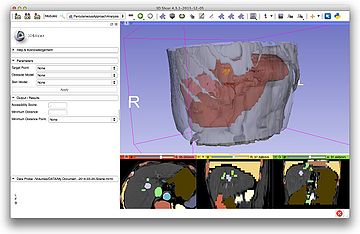
2. Put fiducial
Putting a fiducial point at target position
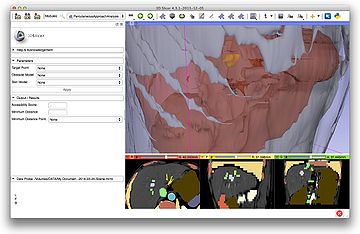
3. Input and Run
Selecting an appropriate object on each parameter pull-down window and push ‘Apply’ button
If you input ‘Minimum Distance Point’ in Output field, the nearest point from the target will be displayed on the Body Surface model.
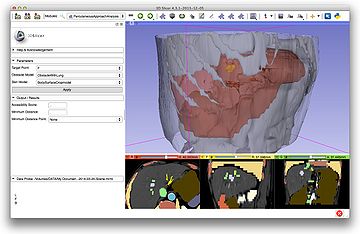
4. Output field
Accessibility score and Minimum Distance are displayed in the result field.

5. Scalar map
A color map showing approachable and inapproachable area is available.
To visualize it, a ‘visible’ check-box should be turned on in Scalar parameter of Models module.
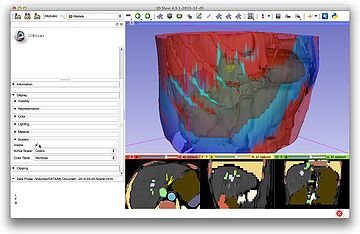
Panels and their use
Parameters panel
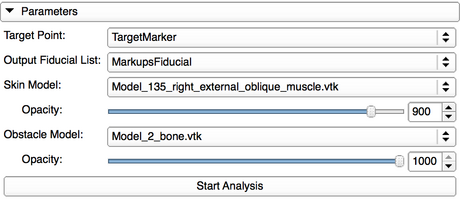
|
- Parameters panel
- Target Point requires a MarkupsFiducial List created in Markups Module which has one target markup.
- Output Fiducial List requires a MarkupsFiducial List created in Markups Module which has no markups.
- Skin Model requires a model which represents a skin, that is a surface consists of the candidates of the needle entry points.
- Opacity Slider can change the opacity parameter for the Skin Model selected.
- Obstacle Model requires a model which represents the obstacle needle paths should avoid.
- Opacity Slider can change the opacity parameter for the Obstacle Model selected.
- Start Analysis button starts calculating path candidates from the skin model to the target point to avoid the obstacle model.
Outcomes panel
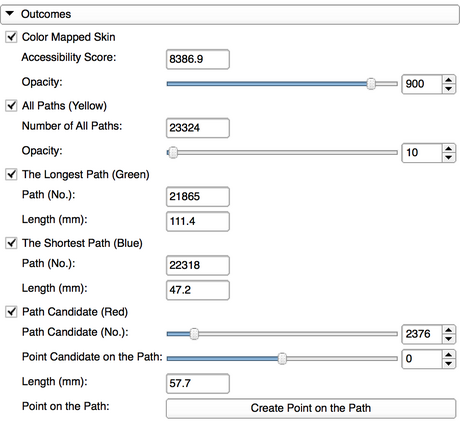
|
- Outcomes panel
- Color Mapped Skin check button visualizes a color map showing approachable and inapproachable areas on the skin model.
- Accessibility score is displayed in the result field.
- All Paths (Yellow) check button visualizes all path candidates shown as the yellow bundles of lines.
- Opacity Slider can change the opacity parameter for the yellow bundles.
- The Longest Path (Green) check button displays the longest path as the green line.
- The Shortest Path (Blue) check button displays the shortest path as the blue line.
- The Path Candidate (Red) check button displays the one of the yellow bundles as the red line.
- Path Candidate (No.) Slider can select a red line from the yellow bundles.
- Point Candidate on the Path Slider can extend and shrink the selected red line from the skin entry point.
- Create Point on the Path button adds the entry position to the Output Fiducial List you set in the Parameters panel.
Cleaning Outcomes panel

|
- Cleaning Outcomes panel
- Delete the Created Paths button erases the all models created by this module.
- Delete the Created Transforms button erases the transforms created by this module except the marker transforms.
Similar Modules
N/A
References
[1] Rossi S, Di Stasi M, Buscarini E, Cavanna L, Quaretti P, Squassante E, Garbagnati F, Buscarini L. (1995) Percutaneous radiofrequency interstitial thermal ablation in the treatment of small hepatocellular carcinoma. Cancer J Sci Am 1(1): 73-81
[2] Silverman SG, Tuncali K, Adams DF, van Sonnenberg E, Zou KH, Kacher DF, Morrison PR, Jolesz FA. (2000) MR Imaging-guided Percutaneous Cryotherapy of Liver Tumors: Initial Experience. Radiology 217: 657-64
[3] Ido K, Isoda N, Sugano K. (2001) Microwave coagulation therapy for liver cancer: laparoscopic microwave coagulation. J Gastroenterol 36(3): 145-52
[4] Khlebnikov R, Kainz B, Muehl J, Schmalstieg D. (2011) Crepscular Rays for Tumor Accessibility Planning. IEEE Trans Vis Comput Graph 17(12): 2163-72
[5] PortPlacement module (used in examples)
[6] SPL Abdominal Atlas (used in examples)
Logo
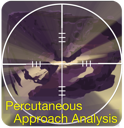
|
Information for Developers
| Section under construction. |

